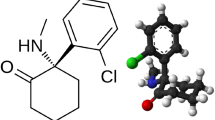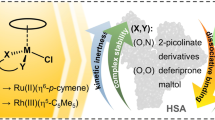Abstract
Purpose. The study was performed for clarifying the mechanism of interaction between indoxyl sulfate (IS), a typical uremic toxin bound to site II, and site I-ligands when bound to human serum albumin (HSA). The effect of the N to B transition on the interactions was also examined.
Methods. Quantitative investigation of the relations between ligands bound to HSA was performed by equilibrium dialysis, and the binding data were analyzed on the basis of a theoretical model for simultaneous binding of two ligands.
Results. The high-affinity binding constants for the site I-ligands warfarin (WF) and dansyl-L-asparagine (DNSA) increased with increasing pH, whereas those for the site II-ligands IS and dansylsarcosine (DNSS) were hardly affected by pH. Mutual displacement experiments showed that even though IS binds to site II it influenced binding of DNSA at the azapropazone binding area in site I. By contrast, it is unlikely that IS affects the WF binding area of site I. Furthermore, pH-profiles showed that the interaction between IS and DNSA was very sensitive to the N to B transition: “competitive-like” strong allosteric regulation was observed for binding of the two ligands to the N conformer (pH 6.5), whereas in the B conformation (pH 8.5) binding of these molecules was nearly “independent”.
Conclusions. The present data provide useful information for elucidating a potential mechanism of interaction between drugs and endogenous substances including uremic toxins.
Similar content being viewed by others
REFERENCES
W. E. Lindup, S. J. Henderson, and C. E. Barker. Drug binding in renal disease. In F. Belpaire, M. Bogaert, J. P. Tillement, and E. Verbeeck (eds.), Plasma Binding of Drug and Its Consequence, Academic Press, Ghent, 1991 pp. 103-120.
W. E. Lindup and C. J. Bowmer. Decreased drug binding in uremia: Effect of indoxyl sulfate and other endogenous substances on the binding of drugs to human albumin. Biochem. Pharmacol. 31:319-323 (1982).
N. Takamura, T. Maruyama, and M. Otagiri. Effect of uremic toxins and fatty acid on serum protein binding of furosemide: Possible mechanism of the binding effect in uremia. Clin. Chem. 43:2274-2280 (1997).
T. Sakai, A. Takadate, and M. Otagiri. Characterization of binding site of uremic toxins on human serum albumin. Biol. Pharm. Bull. 18:1755-1761 (1995).
D. C. Carter and J. X. He. Structure of serum albumin. Adv. Protein Chem. 45:153-203 (1994).
S. Curry, H. Mandelkow, P. Brick, and N. Franks. Crystal structure of human serum albumin complexed with fatty acid reveals an asymmetric distribution of binding sites. Nat. Struct. Biol. 5:827-835 (1998).
K. Yamasaki, T. Maruyama, K. Yoshimoto, Y. Tsutsumi, R. Narazaki, A. Fukuhara, U. Kragh-Hansen, and M. Otagiri. Interactive binding to the two principal ligand binding sites of human serum albumin: Effect of the neutral-to-base transition. Biochim. Biophys. Acta 1432:313-323 (1999).
R. F. Chen. Removal of fatty acids from serum albumin by charcoal treatment. J. Biol. Chem. 242:173-181 (1967).
K. Yamaoka, Y. Tanigawara, T. Nakagawa, and T. Uno. A pharmacokinetic analysis program (MULTI) for microcomputer. J. Pharmacobio-Dyn. 4:879-885 (1981).
U. Kragh-Hansen. Relations between high-affinity binding sites of markers for binding regions on albumin. Biochem. J. 225:629-638 (1985).
T. Peters, Jr. All About Albumin: Biochemistry, Genetics, and Medical Applications, Academic Press, San Diego, California, 1996.
U. Kragh-Hansen. Molecular aspects of ligand binding to serum albumin. Pharmacol. Rev. 33:17-53 (1981).
R. Brodersen, T. Sjödin, and I. Sjöholm. Independent binding of ligands to human serum albumin. J. Biol. Chem. 252:5067-5072 (1977).
K. J. Fehske, W. E. Müller, and U. Wollert. The location of drug binding sites in human serum albumin. Biochem. Pharmacol. 30:687-692 (1981).
K. Yamasaki, T. Maruyama, U. Kragh-Hansen, and M. Otagiri. Characterization of site I on human serum albumin: Concept about the structure of a drug binding site. Biochim. Biophys. Acta 1295:147-157 (1996).
J. Wilting, W. F. van der Giesen, L. H. M. Janssen, M. M. Weideman, M. Otagiri, and J. H. Perrin. The effect of albumin conformation on the binding of warfarin to human serum albumin. The dependence of the binding of warfarin to human serum albumin on the hydrogen, calcium and chloride ion concentrations as studied by circular dichroism, fluorescence, and equilibrium dialysis. J. Biol. Chem. 255:3032-3037 (1980).
J. Wilting, B. J. Hart, and J. J. de Gier. The role of albumin conformation in the binding of diazepam to human serum albumin. Biochim. Biophys. Acta 626:291-298 (1980).
S. Wanwimolruk and D. J. Birkett. The effects of N-B transition of human serum albumin on the specific drug-binding sites. Biochim. Biophys. Acta 709:247-255 (1982).
O. J. M. Bos, J. F. A. Labro, M. J. E. Fischer, J. Wilting, and L. H. M. Janssen. The molecular mechanism of the neutral-to-base transition of human serum albumin. An acid/base titration and proton nuclear magnetic resonance studies on a large peptic and a large tryptic fragment of albumin. J. Biol. Chem. 264:953-959 (1989).
Author information
Authors and Affiliations
Rights and permissions
About this article
Cite this article
Sakai, T., Yamasaki, K., Sako, T. et al. Interaction Mechanism Between Indoxyl Sulfate, a Typical Uremic Toxin Bound to Site II, and Ligands Bound to Site I of Human Serum Albumin. Pharm Res 18, 520–524 (2001). https://doi.org/10.1023/A:1011014629551
Issue Date:
DOI: https://doi.org/10.1023/A:1011014629551




